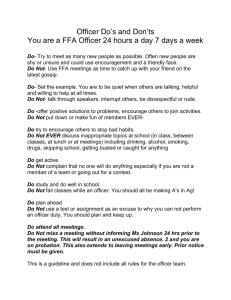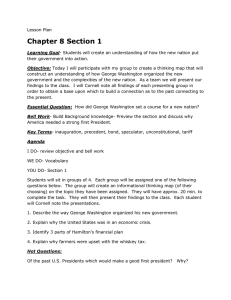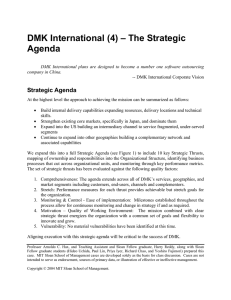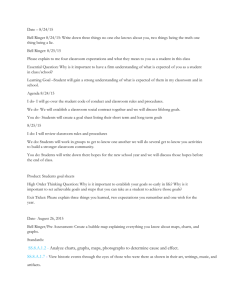DMK International (8) – Aggregate and Granular Metrics) Evaluation
advertisement
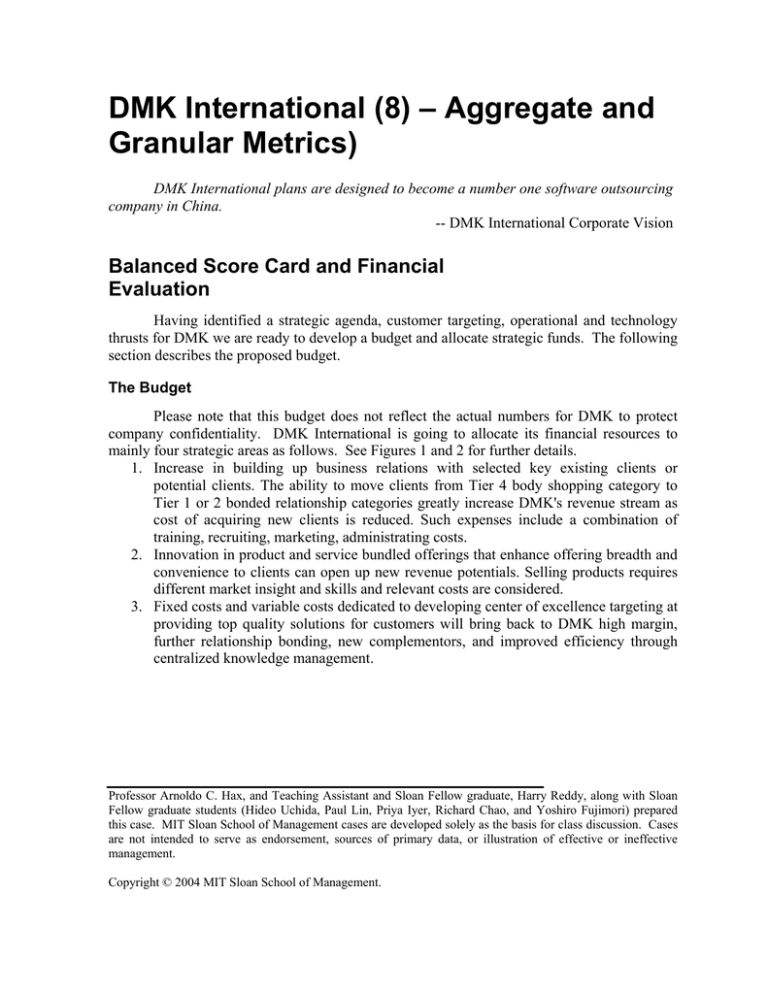
DMK International (8) – Aggregate and Granular Metrics) DMK International plans are designed to become a number one software outsourcing company in China. -- DMK International Corporate Vision Balanced Score Card and Financial Evaluation Having identified a strategic agenda, customer targeting, operational and technology thrusts for DMK we are ready to develop a budget and allocate strategic funds. The following section describes the proposed budget. The Budget Please note that this budget does not reflect the actual numbers for DMK to protect company confidentiality. DMK International is going to allocate its financial resources to mainly four strategic areas as follows. See Figures 1 and 2 for further details. 1. Increase in building up business relations with selected key existing clients or potential clients. The ability to move clients from Tier 4 body shopping category to Tier 1 or 2 bonded relationship categories greatly increase DMK's revenue stream as cost of acquiring new clients is reduced. Such expenses include a combination of training, recruiting, marketing, administrating costs. 2. Innovation in product and service bundled offerings that enhance offering breadth and convenience to clients can open up new revenue potentials. Selling products requires different market insight and skills and relevant costs are considered. 3. Fixed costs and variable costs dedicated to developing center of excellence targeting at providing top quality solutions for customers will bring back to DMK high margin, further relationship bonding, new complementors, and improved efficiency through centralized knowledge management. Professor Arnoldo C. Hax, and Teaching Assistant and Sloan Fellow graduate, Harry Reddy, along with Sloan Fellow graduate students (Hideo Uchida, Paul Lin, Priya Iyer, Richard Chao, and Yoshiro Fujimori) prepared this case. MIT Sloan School of Management cases are developed solely as the basis for class discussion. Cases are not intended to serve as endorsement, sources of primary data, or illustration of effective or ineffective management. Copyright © 2004 MIT Sloan School of Management. Investment in several key technologies such as ERP and collaboration tools that will serve high value customer better, while bringing operation costs down. The implementation will require costs in tangible assets, project trials, new recruits and training of people. Figure 1: Splitting the Profit and Loss Statement of a Division in Terms of Operational and Strategic Expenses Conventional Statement Operational Expenses 100 100 50 10 15 45 7 5 Gross Margin Less: Marketing expneses Admin. Expenses Training expenses 25 33 2 8 3 1.5 6 2 Division margin Operating margin Total strategic expenses 12 Sales Revenue Less: Labor Variable Costs Fixed Costs Strategic Expenses 5 3 10 0.5 2 1 23.5 11.5 Figure 2: Strategic Funds Programming and Operational Budgets Historical and Projected P/L Sales Revenue Operating COGS Gross Operating Margin Operating SG&A Operating Margin Strategic Expenses EBITA Taxes Net Income 2001 13.00 8.61 4.39 3.69 0.70 0.20 0.50 0.10 0.40 Growth Ratio Sales Revenue Operating COGS Gross Operating Margin Operating SG&A Operating Margin Strategic Expenses EBITA Taxes Net Income 2001 (Million $) History 2002 16.00 10.15 5.85 4.35 1.50 0.25 1.25 0.25 1.00 2003 18.00 10.50 7.50 4.50 3.00 0.50 2.50 0.50 2.00 Current 2004 20.00 10.33 9.68 4.43 5.25 0.88 4.38 0.88 3.50 2005 23.00 11.20 11.80 4.80 7.00 2.00 5.00 1.00 4.00 Projections 2006 26.00 11.90 14.10 5.10 9.00 3.38 5.63 1.13 4.50 2007 30.00 12.60 17.40 5.40 12.00 5.50 6.50 1.30 5.20 History 2002 +0.23 +0.18 +0.33 +0.18 +1.14 +0.25 +1.50 +1.50 +1.50 2003 +0.13 +0.03 +0.28 +0.03 +1.00 +1.00 +1.00 +1.00 +1.00 Current 2004 +0.11 -0.02 +0.29 -0.02 +0.75 +0.75 +0.75 +0.75 +0.75 2005 +0.15 +0.08 +0.22 +0.08 +0.33 +1.29 +0.14 +0.14 +0.14 Projections 2006 +0.13 +0.06 +0.19 +0.06 +0.29 +0.69 +0.13 +0.13 +0.13 2007 +0.15 +0.06 +0.23 +0.06 +0.33 +0.63 +0.16 +0.16 +0.16 Aggregate Metrics and the Balanced Score Card We identified the balanced score card dimensions for the entire firm and for each customer segment tier. The balanced score card (as shown in Figure 3) will allow this firm to monitor its executions of customer targeting and innovative strategies, representing changes of key cost drivers of financial perspective, operational effectiveness, technology (organization learning) and customer perspective. Financial Perspective: Financial indicators such as revenue, earnings, and growth rate should be monitored by technology segments, customer segments, geographical diversity, and business domains (capital, industrial and governmental). In addition, because DMK International is in an emerging offshore outsourcing industry, it is more significant to measure planning gaps in order for the firm to recognize required level of capability to serve clients, than it is for firms in a matured and stable industry. Operational Effectiveness: Six sigma activities that DMK International has already introduced will provide the firm with key indicators of operational effectiveness (OE). In addition, the penetration and productivity of foreign language capability of employees, which are measured by the number of passing language tests, affects OE significantly. In tier one and two, which are in the stage of system lock-in of the Delta Project, “Cost to serve clients” is regarded as a dimension of OE rather than that of customer targeting (CT), due to the nature of the service industry, in which it is difficult or meaningless to detach the cost to serve clients from delivery costs of OE. Technology (Organization Learning): The sustainable growth of DMK as a whole depends on how effectively the firm acquires new technologies and enhances its core capabilities that provide competitive advantage, such as ERP, CRM and collaboration tools. In tier 1, the customer segment of exclusive partners, the percentage of revenue of project using in-house IBM mainframe in Dalian shows technological strength for DMK International to serve them without IBM supports. In tier four, from a great pool of temporary clients, this firm needs to create efficient relationship with new clients, which are possible to reach long term relationship with DMK International. Customer Targeting: The wallet share and level of customer satisfaction in each tier indicate the degree of customer bonding with DMK International. In tier one and two, because of long-term relationships with these customer segments, outcome of six sigma activity in dedicated teams at clients (ACFT: At Customer For Customer) and the entire of process re-engineering are significant not only for OE perspective but also for CT perspective. In addition, since DMK International needs to reinforce its technological capability, especially in terms of system architecture, with consultants like Accenture, its profit share with complementors shows how it is able to provide enough total solutions to satisfy clients. Figure 3: Balanced Score Card Dimensions Balanced Scorecard Framework Company Financial Perspective (Shareholder Look) Business Process (Operational Effectiveness) Volume, revenue, earning, gross margin by tech. segment and/or market segment (actual vs. plan) Revenue and earnings by geographical segment (China, US &Japan) Revenue and earnings by business domain (Capital, Industrial & Government) Capacity utilization by engineer idle time Saving derived from six sigma productivity Six sigma GB/BB/MBB penetration Budget vs. plan (facility in China, US & Japan) Number of employees passing language tests Organizational Learning (Technology) Customer Perspective (Customer Targeting) •Percent of sales from new tech. domain by market segment •Training as percent of sales •ERP/CRM/Collabo ration Tool implementation timeline Customer market share by tier Profitability by customer tier Customer satisfaction by tier Balanced Score Card Dimensions (continued) Balanced Scorecard Framework Tier 1 Exclusive Partner Japanese companies requiring outsourcing of mainframe applications Financial Perspective (Shareholder Look) Business Process (Operational Effectiveness) Organizational Learning (Technology) Volume, revenue, earning, gross margin by individual clients. (actual vs. plan) Year over year sales and earnings growth by individual clients. (actual vs. plan) Return on Business Relationship investment ROI on mainframe total investment Cost to serve clients. Saving derived from six sigma joint projects with clients Budget vs. plan (facility in Japan) •% revenue from projects using inhouse IBM Mainframe •% revenue from projects using client IBM Mainframe •Number of clients on DMK ERP Customer Perspective (Customer Targeting) Value-add from six sigma -ACFC (GE “At Customer For Customer”) initiatives -Process reengineering Joint revenue/earnings from complementor relationship (customer ROI) Customer satisfaction on -Project deliverables -Relationship Balanced Score Card Dimensions (continued) Balanced Scorecard Framework Tier 2 Strategic/ Integrated Partner Long term, symbiotic partnership with client resulting in high value to both parties Financial Perspective (Shareholder Look) Business Process (Operational Effectiveness) Volume, revenue, earning, gross margin by individual clients. (actual vs. plan) Year over year sales and earnings growth by individual clients. (actual vs. plan) Return on Business Relationship investment Cost to serve clients. Saving derived from six sigma joint projects with clients Budget vs. plan (facility in Japan, US, China) % revenue from sales derived from DWH Organizational Learning (Technology) Number of clients on DMK ERP •ROI on EAI initiatives •ROI on collaboration tools per selected client •ROI and % revenue on center of excellence establishment • Customer Perspective (Customer Targeting) Value-add from six sigma -ACFC (GE “At Customer For Customer”) initiatives -Process reengineering Joint revenue/earnings from complementor relationship (customer ROI) Customer satisfaction on -Project deliverables -Relationship Balanced Score Card Dimensions (continued) Balanced Scorecard Framework Tier 3: Project Solutions Seeker Full project ownership and solution delivery responsibility without established (but with opportunity for establishing) a long term client relationship. Financial Perspective (Shareholder Look) Volume, revenue, earning, gross margin by individual clients. (actual vs. plan) Return on marketing investment % revenue from clients moved into Tier3 Business Process (Operational Effectiveness) Marketing cost per client ROI on collaboration initiatives % revenue, volume, earnings by channel: -referral by clients -referral by JBCC -direct: pull&push -cross selling Cost of training per project Organizational Learning (Technology) Customer Perspective (Customer Targeting) ROI on collaboration tools per selected client •ROI on software license per project Cost to serve clients per channel Customer satisfaction on -Project deliverables -Relationship • Balanced Score Card Dimensions (continued) Balanced Scorecard Framework Tier 4: Body Shopper Transactional relationship to provide supplemental staff without much end client relationship. Financial Perspective (Shareholder Look) Volume, revenue, earning, gross margin by individual clients. (actual vs. plan) ROI per head % revenue from new clients Business Process (Operational Effectiveness) Time to complete the transaction from start to finish per project Engineer idle time ROI on collaboration initiatives % revenue, volume, earnings by channel: -referral by clients -referral by JBCC -direct: pull&push -cross selling Cost of training per project Organizational Learning (Technology) •Cost of collaboration tool to facilitate knowledge transfer Customer Perspective (Customer Targeting) Cost to serve clients per channel Customer satisfaction on -Project deliverables -Relationship -Cost Performance Metrics for the Business Drivers of the Delta Model In this section, we summarize all of DMK International’s strategy derived from this project by creating the performance metrics for the firm’s business drivers of the delta model. This is done by balancing between coherencies in variety of strategies, which range from customer segmentation to technological requirements, and this firm’s resources, which includes not only financial capability but also current customer base. See Figure 31 for details. According to the performance metrics of the Delta Model, DMK International should highly focus on providing Tier one and two clients, which are already the company’s exclusive/strategic partners and in the system lock-in of the Delta model, with new services/products, and capability to delivery new services/products to their partnership. Therefore, the significant dimensions in the performance metrics should be percentage of strategic/exclusive partnership acquisition, percentage of business volume from strategic/exclusive partnership and switching costs for complementor and customer. In terms of Tier three, clients attracted to DMK International’s capability to delivery total solutions, DMK International should focus on improving their retention, because they have the potential to be upgraded to exclusive/strategic partners. Therefore, the significant dimensions in the performance metrics should be customer share of percentage of total revenue, customer retention rate, Customers switching costs and the number of customer acquired. See Figure 32 for Performance Metrics by Customer Segment. Figure 1: Performance Metrics for the Business Drivers of the Delta Model Best Product (Tier-4 customer) Total Customer Solutions (Tier-3 customer) System Lock-In (Tier-1 and 2 customer) Operational Effectiveness ( Cost Drivers) •Cost of engineer idle time - Breakdown by skills, years experience, level •Cost of training and retraining delivery •Channel cost -Average sale per account •Customer value chain •Impact on customer profit due to DMK services vs. competitors -% work completed per contractual terms -Year of customer tenure -# of customer complain •Cist in training, acquiring, retaining Business Relationship Managers for key accounts •Volume of transaction per service •Customer savings •Measures of affordability, availability, and acceptability Customer Targeting (Profit Drivers •Cost to serve clients per channel •Customer repeat rate •Profit breakdown -referral by clients -referral by JBCC -direct: pull&push -cross selling •Customer share of % of total revenue •Customer retention rate •Customers switching costs •# of customer acquired •# of key customer acquired and retained •Savings through collaboration initiatives •Profit from Center of Excellence initiative through knowledge-base consolidation Innovation (Renewal Drivers) •% of sale from new skills and new clients •Training cost as % of sales •# of bundling service/product •# of customized service offerings •% decrease in time and cost in managing change management •# of strategic/exclusive partnership acquisition •% of business volume from strategic/exclusive partnership •Switching costs for complementor and customer Figure 2: Performance Metrics by Customer Segment For tier-1 and tier-2 customers, they are the company’s exclusive/strategic partners, they are in the system lock-in of the Delta model. Key metrics in the innovation category come from these consideration: Customers in this category is attracted to DMK for its unique skills meeting customer requirements, and its innovation capability. They are in long-term beneficiary relationships. (renewal drivers) The company strategy is to expand on number of partners in this segment. Percentage of revenue from this tier of customer should increase in a steady form. Some of the metrics the company focus on are rate of product and service offering development. Time to ramp-up new services/products, and capability to delivery new services/products to their partnership. The company also evaluates switching costs for complementors and cost of competitors to imitate their services/products. Performance Metrics by Customer Segment (continued) For tier-3 customer, they are the seeking for total solution, they are in the total customer solutions of the Delta Model. Key metrics in the customer targeting category come from these consideration: Customer in this category is attracted to DMK for its capabilityto delivery total solutions. They have the potential to be upgradedto exclusive/strategic partners. The company strategy is focus on customer retention. Percentage of revenue from this tier of customer is also an important indicators. Some of the metrics the company focus on are customer retention rate, and number of bundling service/product used. The company also evaluates number of customer acquired, switching cost for customers. Percentage of expenditure of our services to customer’s total expenditure.
